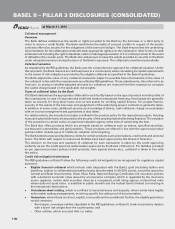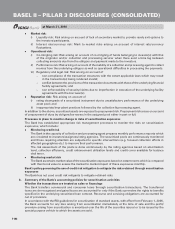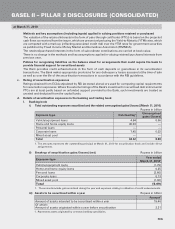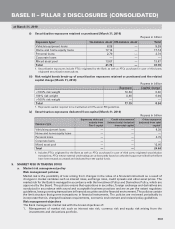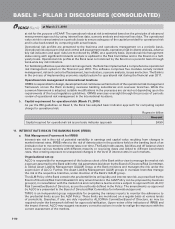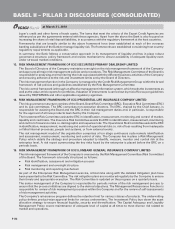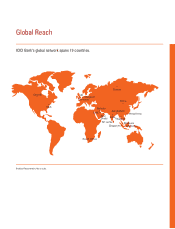ICICI Bank 2010 Annual Report Download - page 191
Download and view the complete annual report
Please find page 191 of the 2010 ICICI Bank annual report below. You can navigate through the pages in the report by either clicking on the pages listed below, or by using the keyword search tool below to find specific information within the annual report.
F111
Risk measurement and reporting framework
The Bank proactively manages impact of IRRBB as a part of its ALM activities. ALM policy defines the different
types of interest rates risks that are to be monitored, measured and controlled. ALCO decides strategies for
managing IRRBB at the desired level. Further, ALCO periodically gives direction for management of interest
rate risk on the basis of its expectations of future interest rates. Based on the guidance, GALM manages the
IRRBB with the help of various tools i.e. gap analysis, earning at risk (EaR), DoE, stress testing for basis risk
etc. These tools are as follows:
z Gap analysis: The interest rate gap or mismatch risk is measured by calculating gaps over different time
intervals as at a given date. This static analysis measures mismatches between rate sensitive liabilities
(RSL) and rate sensitive assets (RSA) (including off-balance sheet positions and trading positions). The
report is prepared fortnightly and the rate sensitive liabilities, assets and off-balance sheet positions, except
for savings deposits, term loans and wholesale term deposits are grouped into time buckets according
to residual maturity or next re-pricing period, whichever is earlier. Behavioral studies are conducted to
estimate the prepayment pattern of term loans, premature withdrawal of wholesale term deposits and
interest rate sensitive portion of savings deposits and these items are bucketed accordingly. The current
account deposits are considered as non-sensitive. The difference between RSA and RSL for each time
bucket signifies the gap in that time bucket. The direction of the gap indicates whether net interest income
is positively or negatively impacted by a change in the direction and magnitude of interest rates and the
extent of the gap approximates the change in net interest income for that given interest rate shift. The
Bank primarily has interest rate gaps in its domestic operations and there are bucket-wise limits on these
gaps, linked to networth of the Bank.
z EaR: From an EaR perspective, the gap reports indicate whether the Bank is in a position to benefit
from rising interest rates by having a positive gap (RSA > RSL) or whether it is in a position to benefit
from declining interest rates by a negative gap (RSL > RSA). The Bank monitors the EaR with respect to
net interest income (NII) based on a 100 basis points adverse change in the level of interest rates. The
magnitude of the impact over a one year period, as a percentage of the NII of the previous four quarters
gives a fair measure of the earnings risk that the Bank is exposed to. The EaR computations include the
banking book as well as the trading book.
For some of the products, Bank provides its depositors and borrowers an option to terminate the deposit/
loan pre-maturely. These products may or may not provide for a penalty for premature termination. In
case of pre-mature terminations, the Bank faces a risk of re-pricing of the assets/liabilities at the current
rates and the resultant impact on the NII (adjusted for the penalty), over and above the impact as estimated
through EAR. However, the re-pricing/re-investment risk is partly mitigated on account of the premature
termination option in wholesale term deposits and term loans being captured through the behavioral
studies implemented in the interest rate gap statement as mentioned in the earlier paragraphs.
z Stress test for basis risk: The assets and liabilities on the balance sheet are priced based on multiple
benchmarks and when interest rates fluctuate, all these different yield curves may not necessarily move in
tandem exposing the balance sheet to basis risk. Therefore, over and above the EaR, the Bank measures
the impact of differential movement in interest rates across benchmark curves. For the domestic operations
various scenarios of interest rate movements (across various benchmark yield curves) are identified and
the worst-case impact is measured as a percentage of the aggregate of Tier-1 and Tier-2 capital. These
scenarios take into account the magnitude as well as the timing of various interest rate movements
(across curves). Currently, the scenarios provide for differential movements in each yield curve but the
movement in each curve is assumed to be parallel. Further, for the overseas operations of the Bank, assets
and liabilities are primarily linked to LIBOR and the basis risk is computed for a parallel shift in LIBOR as
well as spread over LIBOR for the borrowings of the Bank. The basis risk for the Bank is summations of
the risk on domestic and overseas operations.
z DoE: Change in the interest rates also have a long-term impact on the market value of equity of the
Bank, as the economic value of the Bank’s assets, liabilities and off-balance sheet positions get affected.
Duration is a measure of interest rate sensitivity of assets, liabilities and also equity. It may be defined as
the percentage change in the market value of an asset or liability (or equity) for a given change in interest
rates. Thus DoE is a measure of change in the market value of equity of a firm due to the identified change
in the interest rates. The Bank uses DoE as a part of framework to manage IRRBB for its domestic and
overseas operations and has devised limits for the above risk metrics in order to monitor and manage
IRRBB. The DoE computations include the banking book as well as the trading book. The utilisation against
these limits is computed for appropriate interest rate movements and monitored periodically.
Most of the other banking entities in the Group, wherever applicable, also monitor IRRBB through similar tools
and limit framework.
BASEL II – PILLAR 3 DISCLOSURES (CONSOLIDATED)
at March 31, 2010



